Highly important early manuscript map of the Town of North Akron, Ohio (then officially known as Cascade), prepared in the same year as the merger of North Akron and South Akron into a single town (Akron).
The map illustrates the town plat, including the lots then available for sale, with pencil annotations on the left showing the cost of the lots ($300 to $650 per lot), and an annotation in ink at the bottom reflecting the sale of 2 lots on May 8th, 1837. The purchaser is Wm. W. Wadsworth Esq. These apparently reflect 2 of the first 8 lots sold in the original town plan.
Akron traces its modern history to the acquisition of land by General Simon Perkins, commissioner of the Ohio Canal Fund and ardent promoter of the Western Reserve. Perkins purchased land in the area of Portage Summit, while planning the canal across the summit and down river to Lake Erie. In 1811, Paul Williams acquired one-third of the land purchased by Perkins and suggested the creation of a plat for a town on what would become the Ohio Canal. This suggestion led to the first town plan of Akron (South Akron), which was completed and filed in the Portage County Courthouse on July 4, 1825 (Summit County was part of Portage County until 1840).
In 1832, the Canal opened. In 1833, the Village of Cascade was founded by Dr. Eliakim Crosby, a hydraulic engineer and entrepreneur who built the Cascade Race, a waterway that powered the mills and businesses along the Canal. The Cascade Race helped transform Akron into a boomtown and Dr. Crosby may rightly be called the father of Akron. Ironically, Dr. Crosby's success came at the expense of John Brown, the famous abolitionist, who was actively speculating on the development of real estate in the neighboring village of Franklin Mills, with the expectation that the Canal would spur its growth. Among Brown's purchases was the 100 acre Haymaker Farm, which was financed in part by a loan from Ohio Canal Commissioner and future Akron Mayor (1852) Frederick Wadsworth. While Brown did secure the the contract for the construction of the canal from Franklin Mills to Akron, his real estate speculation proved disasterous and he left the area during the Panic of 1837.
Dr. Crosby began purchasing land along the Cuyahoga River. His purchases included most of North Hill and areas eastward to the old Portage Township line near Bettes Corners. He formed a partnership with several investors, including Simon Perkins, Frederick Wadsworth, and Eleazer Sackett, which led to the creation of the Portage Canal & Manufacturing Co. on February 27, 1837. The company was formed to construct a dam and a waterway that would bring water power to the two villages. This waterway became known as the "Chuckery Race". The race opened on May 27, 1844, but never became commercially viable.
On March 12, 1836, the merged villlages of Akron received a city charter from the state of Ohio. At the time, the combined population was 1,343. At the time of the Panic of 1837, there were still only 14 stores in North Akron, all but 3 of which failed, suggesting the population was still well under 500 people at the time this map was drawn.
One of the great ironies of this map is the confluence of several American mapmakers who apparently did not participate in its preparation. By 1837, Lewis Robinson had established an office in Akron and was listing Akron as the place of publication for his maps (having previously been in Reading, Vermont). In January 1837, Leander Ransom (whose name would later appear on the highly important "Holt Map" of California first published in 1862) was then serving as acting commissioner of the Ohio State Canal Commission and was in Akron, making the final decision to switch the "summit" of the canal from Middlebury, where it was originally planned, to Akron.
While we have not done an exhaustive search on the identity of the buyer, it would appear that Colonel (?) Willam W. Wadsworth of Genessee, NY (Village President in 1845) was actively purchasing land in Northwestern Ohio in the 1830s. The History of the City of Toledo and Lucas County Ohio notes that William W. Wadsworth of Genessee, NY purchased 500 acres of land in Adams Township in 1834. He was apparently a relative of James S. Wadsworth of Livingston, NY. In his will, James S. Wadworth noted the acquitision of 24,000 acres of land in Northwestern, Ohio in 1836 and also noted that Wm. W.Wadsworth (relationship not known), had purchased land in a number of Ohio localities during the same time period. James and William Wadsworth (1761-1833) first settled the Genessee Valley as land agents for their uncle, Colonel Jeremiah Wadsworth, Commissary General of the Revolutionary Army under George Washington. James Wadworth mentions both a William W. Wadsworth (father) and a William A. Wadsworth (son) in his will, but we have not been able to verify the familial connection.
A remarkable early piece of Akron's history, including notes in a contemporary hand on the price of lots and an early real estate transaction.









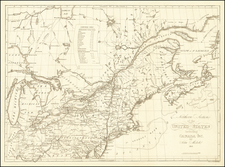
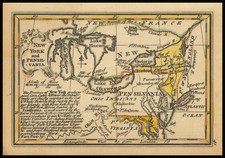
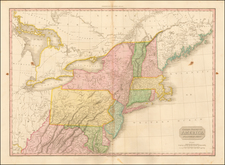
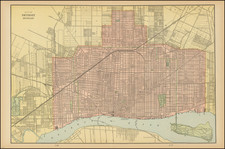
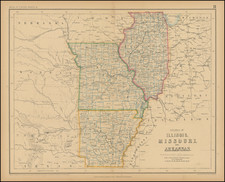
![Carte Qui Contient La Maniere Dont Se Fait La Chasse Des Bouefs Sauvages . . . [Buffalo, Niagara Falls, Calumet Village, Huron & Illinois Indians]](https://storage.googleapis.com/raremaps/img/small/93146.jpg)